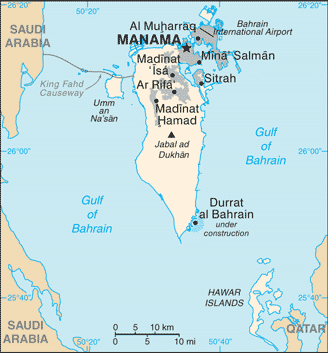Topics Covered
Welcome to Bahrain
Overview of Resources
Metals
Industrial Minerals
Fossil Fuels
Investment
Sources
Welcome to Bahrain
Bahrain is an archipelago in the Persian Gulf, located to the east of Saudi Arabia. The nation is a part of the Middle East countries with a total area of 760 km2. It has a population of 1,248,348 as of July 2012. The country experiences a mostly arid climate.
 |
The national flag of Bahrain.
Image Credit: CIA Factbook. |
Bahrain gained its independence in 1971 and ever since was troubled by the conflicts between the Sunni and Shia factions. After political talks between the two sides failed and civil protests became widespread in 2011 and Bahrain opted to have a contingent of Saudi and Emirati military forces to help Bahraini security forces maintain law and order. Despite many new government measures to appease the Shia population, the protests still continue affecting the country’s economy badly. The GDP of Bahrain in 2011 was $31.5 billion.
Bahrain’s most significant natural resources are oil and associated and non-associated natural gas. The country's economy greatly depends on oil. However, the government hopes to diversify into other sectors. Mineral commodities produced in the country include aluminum, cement, nitrogen fertilizer, iron ore pellets from imported iron ore, methanol, sulfur, and sand.
Overview of Resources
Bahrain’s petroleum production and refining is estimated to account for more than 70% of government revenues, 60% of its export income, and 11% of GDP. The other significant mining activity in 2011 was aluminum production.
The country has one of the largest aluminum smelters in the world in terms of production volume. In 2010, Bahrain was the world’s ninth largest producer of aluminum accounting for 2.4% of the world’s total aluminum production.
Bahrain encourages exploration activities especially for new natural gas supplies so as to be able support its expanding petrochemical and aluminum industries.

The map of Bahrain. Image Credit: CIA Factbook
Metals
In 2010, Alba produced 850,700 Mt of finished aluminum products and contributed about 12% of the GDP. The company employed more than 3,000 people.
In 2009, Pearl Industrial Chemical Co. was established by a $100 million joint venture between EBH Holding and Archean Group of India to build a 60,000- t/yr-capacity aluminum fluoride plant in Bahrain. The construction work was expected to be completed by 2011.
Gulf Industrial Investment Co. (GIIC) opened the $700 million pelletizing plant no. 2 at the Hidd Industrial Area in 2010. This plant was designed with the capacity to produce 6 Mt/yr of iron ore pellets and 100,000 t/yr of stainless steel.
In the same year, Foulath and Yamato Kogyo Co. Ltd. of Japan planned to build a $1.2 billion steel mill at the Hidd Industrial Area.
Industrial Minerals
Since Bahrain does not have adequate raw materials for cement production, it imports most of its raw materials.
The Falcon cement factory owned by Capivest Islamic Investment Bank began production in 2009. In 2010, the production capacity increased to 1.2 Mt/yr of cement from 438,000 t/yr in 2009.
The clinker-grinding mill operated by Star Cement was acquired by UltraTech Cement Middle East Investments Ltd. of India in 2010. This mill is capable of producing 500,000 t/yr of cement.
The petrochemical plant owned and operated by Gulf Petrochemical Industries Co. B.S.C (GPIC) was capable of producing 400,000 t/yr of ammonia and 600,000 t/yr of urea in 2010. It employed 574 people and proposed a $700 million expansion plan to increase production capacity to 766,500 t/yr of ammonia and 1.3 Mt/yr of urea.
Fossil Fuels
Bahrain’s crude oil reserves and natural gas reserves as of 2011 were estimated to be 125 million bbl and 92 billion m3, respectively.
Bahrain Petroleum Co., B.S.C. (Bapco) had several projects lined up in 2010. The following are some of them:
- $350 million Arabia pipeline construction project with Saudi Arabian Oil Co.
- $15 billion Bahrain field phased development project
- $1 billion construction of liquefied natural gas import terminal
- $431 million low-sulfur diesel production facility
- $2 billion upgrade and expansion of the Sitra refinery.
Similarly, in 2010, Bahrain National Gas Co., B.S.C. (BANAGAS) continued its $100 million construction project of a gas compressor station, and Bahrain Base Oil Co. continued its construction project of building a $430 million lube oil refinery. National Oil and Gas Authority (NOGA) was involved in exploration and expansion activity at the Awali oilfield.
Investment
Bahrain’s economy is facing a downturn largely due to the civil turmoil that plagues the nation. The government is forced to pay attention to this rising crisis thereby slowing down economic progress. The IMF has also predicted that the economic growth rate is likely to steadily decrease.
However, the country has been attracting investments to its mining sector. In 2011, the world’s first integrated steel company United Steel Company (SULB) located in Bahrain announced that it was talking terms with four companies to invest between $3 billion to $5 billion in Bahrain’s mining industry. SULB is a joint venture between Bahrain-based Gulf United Steel Holding Company (Foulath) with 51% interest and Japan’s Yamato Kogyo Co. Ltd, with 49%. SULB had also granted Nass Contracting WLL (Nass) with a Civil Integration Package for its $1.2 billion integrated steel project in Bahrain.
Disclaimer: The Author of this article does not imply any investment recommendation and some content is speculative in nature. The Author is not affiliated in any way with any companies mentioned and all statistical information is publically available.
Sources
http://minerals.usgs.gov/minerals/pubs/country/2010/myb3- 2010-ba.pdf
https://www.cia.gov/the-world-factbook/countries/bahrain/
http://www.twentyfoursevennews.com/headline/sulb-keen-on-investing-3b-to-5b-in-mining-sector-chairman-sulb/
Disclaimer: The views expressed here are those of the author expressed in their private capacity and do not necessarily represent the views of AZoM.com Limited T/A AZoNetwork the owner and operator of this website. This disclaimer forms part of the Terms and conditions of use of this website.